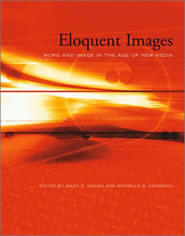
Home / Introduction / Part I / Part II / Part III / Part IV / Conclusion

II. Historical Relationships between Word and Image
Ch. 4 "Recovering the Multimedia History of Writing in the Public Texts of Ancient Egypt." (top)
Carol Lipson
This essay begins Section II of the book, Historical Relationships between Word and Image, by offering a look at past multimedia representations in order to shed light on new present day multimedia forms. In doing so, Lipson draws on Bolter and Grusin's theory of remediation to once again explore the notion that new multimedia is not revolutionary but rather has borrowed approaches from the past, a theme that, as noted earlier, is developed throughout the book. Lipson relies on Robert Horn's Visual Language and his use of the Gestaltian general principles of proximity, similarity, common region, connectedness, directional continuity, and closure to present her own analysis of several ancient Egyptian artifacts that allow her an interesting way of looking at image-texts. She finds that by examining such multimodal objects, she is able to conclude that while the image-texts can have multiple meanings, they can also have contradictory meanings as well. She ends her essay with some implications for the digital era that she hopes will encourage the creation of complex meanings.
Ch. 5 "Digital Images and Classical Persuasion." (top)
Kevin LaGrandeur
Working from classical rhetoric, LaGrandeur provides a practical demonstration of an analysis of present day multimedia, specifically web-based images. To begin with, LaGrandeur asks us to consider Aristotle, Gorgias, and Horace as examples of how we can link images to persuasion and in doing so it becomes clear that this linkage is an old concept. From these examples, he then considers George Campbell's Philosophy of Rhetoric (since it harkens back to the ideas of Aristotle, Gorgias, and Horace) to build on his idea of imitation that suggests, for instance, that images serve as a means of comparison and thus rational judgment (p. 124).
The next step for LaGrandeur, then, is to take what has been said and to apply it to modern contexts. To do so, he gives a useful model for looking at the persuasive impact of digital images, a model that incorporates an examination of ethos, pathos, and logos. Then, he demonstrates the model in three test cases in which he discusses his classroom experiences with teaching web design. For example, he discusses an instance where he asks his students to create a simple home page from which his students would link their assignments. He is surprised to find his students have a preoccupation with their graphics and subsequently investigates why. In doing so, he discovers that the images on the students' homepages represent an example of Campbell's theory of images, that is, the images chosen by the students' draw attention, invite comparison, and generate emotional response.
After his presentation of the test cases, LaGrandeur follows with a warning about the persuasiveness of digital images. Relying on a study from Ohio State University, LaGrandeur notes that "the strong pathetic effect of digital images can distract one from any kind of logos that the site might convey" (p. 132). In other words, he says there is a limitation to digital graphics. In the end, LaGrandeur finally concludes that a redeployment of classical notions can help to understand the rhetorical context of digital images.
Ch. 6 "The Word as Image in an Age of Digital Reproduction." (top)
Matthew Kirschenbaum
To begin his essay, Kirschenbaum offers a brief history of the technologies for reproducing words and images in order to relate it to his experience working in the field of applied humanities computing. This discussion leads him to say that "one cannot talk about words as images and images as words without taking into account the technologies of representation upon which both forms depend" (p. 141). In other words, he is prompted to address the problems associated with how images and words are created, particularly, in this case, for the web.
Kirschenbaum shifts the focus of the conversation to new ontologies and, in doing so, notes Johanna Drucker's rethinking and reconfiguring of the word in electronic environments. However, Kirschenbaum contends that "the boundary between words and images is no more fluid than when they were transmitted with the halftone screen, the engraver's burin, or the woodcutter's knife" (p. 143). From here, the author provides several examples from his own work in the field of applied humanities computing—particularly with developing image searching capabilities—that prompt him to speculate which kind of data is useful and why. To conclude and shed light on his experiences, he reiterates that there is still a divide between the reproductions of words and the reproductions of images. Furthermore, he contends, the belief that "digital texts and images are infinitely fluid and malleable is an aesthetic conceit divorced from technical practice" (p. 154).Home / Introduction / Part I / Part II / Part III / Part IV / Conclusion